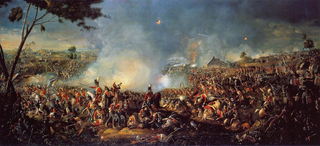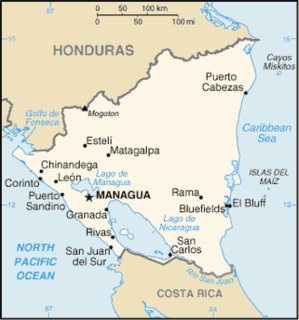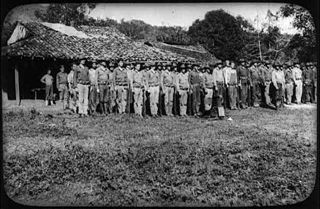The Battle of Santa Clara took place on 27 July 1927, during the American occupation of Nicaragua of 1926–1933. After being ambushed by Sandinista forces at the Battle of San Fernando, Major Oliver Floyd's expedition of American Marines and Nicaraguan Provisional Guardsmen continued its advance into enemy-held territory in northern Nicaragua.

The United States occupation of Nicaragua from 1912 to 1933 was part of the Banana Wars, when the US military intervened in various Latin American countries from 1898 to 1934. The formal occupation began in 1912, even though there were various other assaults by the U.S. in Nicaragua throughout this period. American military interventions in Nicaragua were designed to stop any other nation except the United States of America from building a Nicaraguan Canal.

An ambush is a long-established military tactic in which combatants take advantage of concealment and the element of surprise to attack unsuspecting enemy combatants from concealed positions, such as among dense underbrush or behind hilltops. Ambushes have been used consistently throughout history, from ancient to modern warfare. In the 20th century, an ambush might involve thousands of soldiers on a large scale, such as over a choke point such as a mountain pass, or a small irregular band or insurgent group attacking a regular armed force patrol. Theoretically, a single well-armed and concealed soldier could ambush other troops in a surprise attack.

Augusto C. Sandino, also known as Augusto Nicolás Calderón Sandino, was a Nicaraguan revolutionary and leader of a rebellion between 1927 and 1933 against the U.S. military occupation of Nicaragua. He was referred to as a "bandit" by the United States government; his exploits made him a hero throughout much of Latin America, where he became a symbol of resistance to United States' domination. He drew units of the United States Marine Corps into an undeclared guerrilla war. The United States troops withdrew from the country in 1933 after overseeing the election and inauguration of President Juan Bautista Sacasa, who had returned from exile. The re-call of the Marines was largely due to the Great Depression.
On the 27 July two American airplanes spotted forty Sandinistas waiting in ambush. The aircraft received fire from an enemy machine gun and a dive bombing raid ensued, with three bombs being dropped on the Nicaraguan rebels. The American aviators reported seeing six Sandinistas "dead or seriously wounded." [7]

A dive bomber is a bomber aircraft that dives directly at its targets in order to provide greater accuracy for the bomb it drops. Diving towards the target simplifies the bomb's trajectory and allows the pilot to keep visual contact throughout the bomb run. This allows attacks on point targets and ships, which were difficult to attack with conventional level bombers, even en masse.

A bomb is an explosive weapon that uses the exothermic reaction of an explosive material to provide an extremely sudden and violent release of energy. Detonations inflict damage principally through ground- and atmosphere-transmitted mechanical stress, the impact and penetration of pressure-driven projectiles, pressure damage, and explosion-generated effects. Bombs have been utilized since the 11th century starting in East Asia.
Major Floyd's Marine and Provisional Guard expedition eventually reached the area one mile southeast of Santa Clara, where they were attacked by a force of between 60 and 120 (possibly up to 150 [8] ) Sandinista insurgents who were armed with two machine guns. [9] One of the machine guns was confirmed to be a Lewis gun and the other one was suspected of being one as well. [10]

The Lewis gun is a First World War–era light machine gun of US design that was perfected and mass-produced in the United Kingdom, and widely used by troops of the British Empire during the war. It had a distinctive barrel cooling shroud and top-mounted pan magazine. The Lewis served to the end of the Korean War. It was also widely used as an aircraft machine gun, almost always with the cooling shroud removed, during both World Wars. "The Lewis Gun is the most recognized classic light machine gun in the world."
The battle raged from 2:30 to 4:00, with the Sandinistas being eventually driven back.

A battle is a combat in warfare between two or more armed forces, or combatants. A war usually consists of multiple battles. Battles generally are well defined in duration, area, and force commitment. A battle with only limited engagement between the forces and without decisive results is sometimes called a skirmish.
The American and Nicaraguan government forces didn't suffer any casualties, while five dead rebels were found on the battlefield. However, Augusto César Sandino would later admit to losing up to 60 men killed and wounded during the action (although this number may include the casualties from the air raid prior to the battle). [11] Sandino had a tendency to greatly exaggerate numbers related to the battles during his rebellion, so this number of 60 is probably inaccurate. One young Sandinista, who was pretending to be dead, was captured, but later released. [12]
In addition to human losses, twelve of Sandino's animals were killed and eight were captured. [13]
The clash at Santa Clara, along with the previous battles at Ocotal and San Fernando (both of which also took place in July 1927) convinced Sandino to alter his tactics. According to author Neill Macaulay, "he would attack only when the odds were heavily in his favor-when he clearly had the advantages of surprise, cover, and superior firepower. Never again would he foolishly 'stand his ground,' nor would he try to redeem an attack that had hopelessly bogged down. Major Floyd might wage a 'blood and thunder campaign,' but Sandino would adopt the hit-and-run tactics of guerrilla warfare." [14] After the Battle of Santa Clara, the Sandinistas fell back to "the jungles around El Chipote mountain," which was "ideal country for guerrilla warfare." [15]








